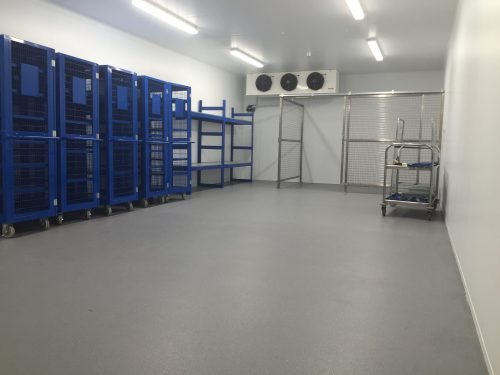ในห้องเย็น, รักษาประสิทธิภาพ, เป็นระเบียบ, และสภาพแวดล้อมที่ปลอดภัยเป็นสิ่งจำเป็นในการรักษาคุณภาพของผลิตภัณฑ์และให้การดำเนินงานที่ราบรื่น. สิ่งหนึ่งที่มักถูกมองข้าม แต่สิ่งสำคัญคือระบบลิ้นชักที่ใช้ในการจัดเก็บสินค้า.
เลือกด้านขวา ห้องเย็น การเก็บเข้าลิ้นชักสามารถสร้างความแตกต่างอย่างมีนัยสำคัญในการเพิ่มพื้นที่, ป้องกันการเน่าเสียของผลิตภัณฑ์, และปฏิบัติตามกฎระเบียบด้านความปลอดภัย. ในบทความนี้, เราจะสำรวจความสำคัญของการเก็บเข้าลิ้นชักห้องเย็น, ประเภทต่างๆที่มีอยู่, และวิธีเลือกระบบลิ้นชักที่ดีที่สุดสำหรับความต้องการเฉพาะของคุณ.
ห้องเย็นห้องเย็นที่เหนือกว่า
คำจำกัดความการเก็บเข้าลิ้นชักห้องเย็น
การเก็บเข้าลิ้นชักห้องเย็นหมายถึงระบบจัดเก็บพิเศษสำหรับใช้ในสภาพแวดล้อมที่ควบคุมอุณหภูมิต่ำ, เช่นพื้นที่เก็บของตู้เย็นหรือแช่แข็ง. ที่อยู่อาศัยเหล่านี้ถูกสร้างขึ้นเพื่อทนต่ออุณหภูมิต่ำและความชื้นสูงในห้องเย็น, ในขณะที่เสนอการใช้พื้นที่อย่างมีประสิทธิภาพ, ความทนทาน, และทำความสะอาดได้ง่าย, ซึ่งทำจากวัสดุที่ทนต่อการกัดกร่อน, เช่นสแตนเลส , พลาสติก, หรือโลหะชุบสังกะสี, เพื่อให้มั่นใจถึงประสิทธิภาพที่ยาวนานในสภาพอากาศหนาวเย็น. เป้าหมายหลักคือการจัดเก็บผลิตภัณฑ์อย่างปลอดภัยในขณะที่ยังคงการไหลเวียนของอากาศที่เหมาะสมเพื่อรักษาคุณภาพของพวกเขา.
เหตุใดชั้นวางห้องเย็นจึงเป็นสิ่งจำเป็น?
เพิ่มพื้นที่จัดเก็บสูงสุด
การใช้พื้นที่แนวตั้งอย่างมีประสิทธิภาพ: ห้องเย็น ชั้นวางช่วยให้สามารถใช้พื้นที่แนวตั้งได้สูงสุด, ซึ่งมีความสำคัญอย่างยิ่งในสภาพแวดล้อมที่ทุกตารางฟุตมีค่า. ระบบลิ้นชักที่เหมาะสมช่วยให้องค์กรดีขึ้น, ดังนั้นผลิตภัณฑ์สามารถเก็บไว้ในเลเยอร์โดยไม่ต้องใช้พื้นที่เพิ่มเติม.
เลย์เอาต์ที่ดีที่สุด: ระบบลิ้นชักสามารถปรับแต่งให้พอดีกับเค้าโครงที่เป็นเอกลักษณ์ของห้องเย็น, ตรวจสอบให้แน่ใจว่าไม่มีพื้นที่ว่าง. สิ่งนี้สำคัญมากในห้องเย็นขนาดเล็กซึ่งความสามารถในการเพิ่มความจุเป็นกุญแจสำคัญในการรักษาประสิทธิภาพ.
รักษาคุณภาพของผลิตภัณฑ์
การไหลเวียนของอากาศ: ชั้นวางห้องเย็น, โดยเฉพาะอย่างยิ่งลิ้นชักลวด, ช่วยส่งเสริมการไหลเวียนของอากาศรอบ ๆ ผลิตภัณฑ์, ตรวจสอบการกระจายอุณหภูมิที่สอดคล้องกัน. นี่เป็นสิ่งสำคัญสำหรับการป้องกันฮอตสปอต, ในกรณีที่ผลิตภัณฑ์อาจแช่แข็งหรือเสียเนื่องจากการระบายความร้อนไม่สม่ำเสมอ.
ป้องกันความเสียหายของผลิตภัณฑ์: โดยการจัดระเบียบสิ่งของเกี่ยวกับการเก็บเข้าลิ้นชักแทนที่จะซ้อนกันบนพื้น, สามารถลดความเสี่ยงของความเสียหายของผลิตภัณฑ์. ชั้นวางช่วยป้องกันผลิตภัณฑ์ออกจากพื้นเย็น, หลีกเลี่ยงการควบแน่นและการปนเปื้อนที่เป็นไปได้.
สนับสนุนมาตรฐานสุขอนามัยและความปลอดภัยของอาหาร
ที่เก็บข้อมูลสูง: ชั้นวางของห้องเย็นช่วยให้ผลิตภัณฑ์สูงขึ้นจากพื้นดิน, ลดความเสี่ยงของการปนเปื้อนจากพื้น. สิ่งนี้จะช่วยให้เป็นไปตามมาตรฐานสุขอนามัย, โดยเฉพาะอย่างยิ่งในการจัดเก็บอาหารที่การรักษาความสะอาดเป็นสิ่งสำคัญ.
ทำความสะอาดง่าย: วัสดุที่ใช้สำหรับชั้นวางห้องเย็น, เช่นสแตนเลสและชุบสังกะสี, ทำความสะอาดและสุขาภิบาลได้ง่าย. การทำความสะอาดเป็นประจำช่วยป้องกันแบคทีเรียและเชื้อราจากการเติบโตในที่เย็น, สภาพแวดล้อมที่ชื้นและมีความชื้นสูง.
ประเภทของห้องเก็บของเย็น
(1).ลวดหนาม
ลวดลวดเป็นตัวเลือกยอดนิยมสำหรับ ห้องเย็น เนื่องจากการออกแบบที่เปิดกว้าง, ซึ่งช่วยให้การไหลเวียนของอากาศที่ยอดเยี่ยม. ทำจากวัสดุที่ทนต่อการกัดกร่อนเช่นสแตนเลสหรือโลหะเคลือบพลาสติกเพื่อทนต่อความชื้น, สภาพแวดล้อมที่หนาวเย็น.
ข้อดี:
1. การไหลของอากาศ
ส่งเสริมการไหลเวียนของอากาศที่สอดคล้องกัน, ตรวจสอบการกระจายอุณหภูมิที่สม่ำเสมอรอบ ๆ ผลิตภัณฑ์ที่เก็บรักษาไว้.
2. ทำความสะอาดง่าย
โครงสร้างแบบเปิดนั้นง่ายต่อการทำความสะอาดและบำรุงรักษา, สามารถปฏิบัติตามมาตรฐานสุขอนามัยได้.
3. ปรับได้
ชั้นวางมักจะปรับความสูงเพื่อรองรับผลิตภัณฑ์ประเภทต่างๆ, กล่องหรือรูปร่าง.
ข้อเสีย:
1. ข้อ จำกัด น้ำหนัก
ชั้นวางสายไฟไม่เหมาะสำหรับโหลดที่หนักมากเนื่องจากมีความทนทานน้อยกว่าชั้นวางของแข็ง.
แอปพลิเคชัน: การจัดเก็บอาหาร, เภสัชกรรม, และห้องเย็นทั่วไปที่ต้องการการไหลเวียนของอากาศรอบ ๆ ผลิตภัณฑ์.
(2).ลิ้นชัก
ชั้นวางของแข็งทำจากวัสดุเช่นสแตนเลสหรือพลาสติกคุณภาพสูง. ไม่เหมือนลิ้นชักลวด, มันมีแฟลต, พื้นผิวที่เป็นของแข็งที่ป้องกันไม่ให้ของเหลวหรือของเหลวหยดผ่านชั้นวาง.
ข้อดี:
1. ความทนทาน
ชั้นวางของแข็งมีความทนทานสูงและสามารถจัดการกับโหลดที่หนักกว่าได้, เหมาะสำหรับการจัดเก็บขนาดใหญ่, สินค้าหนัก.
2. การกัก
ป้องกันการรั่วไหลหรือหยดจากชั้นล่างถึงชั้นล่าง, ช่วยให้มีของเหลวและป้องกันการปนเปื้อนข้าม.
3. สุขอนามัย
ให้พื้นผิวเรียบที่ทำความสะอาดได้ง่าย, เหมาะอย่างยิ่งสำหรับการรักษาความต้องการด้านสุขอนามัยที่เข้มงวด.
ข้อเสีย:
1.การไหลเวียนของอากาศ จำกัด
ไม่เหมือนลิ้นชักลวด, ชั้นวางของแข็งสามารถปิดกั้นการไหลเวียนของอากาศ, ซึ่งอาจส่งผลให้การระบายความร้อนไม่สม่ำเสมอในบางพื้นที่ของห้องเย็น.
แอปพลิเคชัน: สภาพแวดล้อมการจัดเก็บเย็นที่มีน้ำหนักมาก, รายการขนาดใหญ่, หรือที่การกักเก็บการหกเป็นข้อกังวล.
(3).ชั้นวางของมือถือ
ระบบลิ้นชักมือถือสามารถเพิ่มพื้นที่ได้สูงสุดโดยอนุญาตให้ชั้นวางเคลื่อนที่ไปตามแทร็ก. หน่วยเหล่านี้สามารถขยับเข้าด้วยกันได้มากขึ้นหรือแยกออกจากกัน, ไม่จำเป็นต้องมีทางเดินถาวร.
ข้อดี:
1. เพิ่มพื้นที่
กำจัดทางเดินที่ได้รับการแก้ไขและช่วยให้ชั้นวางของในพื้นที่เดียวกันมากขึ้น, เพิ่มปริมาณการจัดเก็บข้อมูล.
2. ความยืดหยุ่น
สามารถเคลื่อนย้ายหน่วยชั้นวางได้อย่างง่ายดายเพื่อสร้างทางเดินเฉพาะเมื่อจำเป็น, อนุญาตให้จัดเก็บข้อมูลที่มีความหนาแน่นสูง.
3. กำหนดเอง
การเก็บเข้าลิ้นชักมือถือสามารถปรับแต่งให้เหมาะกับผลิตภัณฑ์ประเภทต่าง ๆ และความต้องการห้องเย็น.
ข้อเสีย:
1. ต้นทุนที่สูงขึ้น
ระบบลิ้นชักมือถือมีราคาแพงกว่าเนื่องจากความซับซ้อนของระบบ.
2.การเข้าถึง
ต้องมีการวางแผนอย่างรอบคอบในการเข้าถึงผลิตภัณฑ์ที่เก็บไว้, สามารถเปิดทางเดินเพียงครั้งเดียวได้ในแต่ละครั้ง.
แอปพลิเคชัน: ห้องเย็น มีพื้นที่ จำกัด แต่ความต้องการที่เก็บข้อมูลสูง, หรือในกรณีที่การเพิ่มประสิทธิภาพการจัดเก็บเป็นสิ่งสำคัญที่สุด.
(4).ชั้นวางของ
ชั้นวางของไดรฟ์อินเหมาะสำหรับการจัดเก็บความหนาแน่นสูง, โดยที่รถยกจะขับรถเข้าสู่ระบบลิ้นชักโดยตรงเพื่อวางหรือดึงพาเลท. ชั้นวางของนี้เหมาะที่สุดสำหรับห้องเย็นที่มีการจัดเก็บและดึงผลิตภัณฑ์ในปริมาณมาก.
ข้อดี:
1. ที่เก็บความหนาแน่นสูง
ช่วยให้สามารถจัดเก็บผลิตภัณฑ์จำนวนมากในพื้นที่ขนาดกะทัดรัด, ทำให้เหมาะสำหรับการจัดเก็บจำนวนมาก.
2. ประสิทธิภาพพื้นที่
เพิ่มพื้นที่จัดเก็บสูงสุดโดยการกำจัดทางเดินระหว่างชั้นวาง, อนุญาตให้มีผลิตภัณฑ์เพิ่มเติมที่เก็บไว้ในรอยเท้าเดียวกัน.
ข้อเสีย:
1. การเข้าถึงที่ จำกัด
ระบบไดรฟ์อินทำงานบนไฟล์ “สุดท้ายใน, ออกก่อน” พื้นฐาน, หมายถึงผลิตภัณฑ์ที่เก็บไว้ที่ด้านหลังของระบบนั้นยากต่อการเข้าถึง.
2. อุปกรณ์พิเศษที่จำเป็น
ต้องใช้รถยกหรืออุปกรณ์อื่น ๆ เพื่อเข้าถึงผลิตภัณฑ์, ซึ่งจะเพิ่มความซับซ้อนในการดำเนินงาน.
แอปพลิเคชัน: คลังสินค้าที่มีผลิตภัณฑ์เครื่องแบบจำนวนมาก, โดยเฉพาะอย่างยิ่งในอุตสาหกรรมอาหารหรือเครื่องดื่มที่สามารถจัดเก็บสินค้าเป็นจำนวนมาก.
(5).พาเลท
การวางพาเลทเป็นหนึ่งในที่พบมากที่สุด ห้องเย็น ระบบลิ้นชักที่ใช้ในคลังสินค้าขนาดใหญ่. มันสามารถเก็บพาเลทของสินค้า, ให้การเข้าถึงที่ง่ายและการสนับสนุนที่แข็งแกร่งสำหรับรายการหนัก.
ข้อดี:
1. งานหนัก
สามารถรองรับพาเลทหนัก, เหมาะสำหรับการจัดเก็บรายการจำนวนมาก.
2. จัดเก็บข้อมูล
เป็นวิธีที่เป็นระบบในการจัดระเบียบและจัดเก็บพาเลท, ทำให้การจัดการสินค้าคงคลังง่ายขึ้น.
3. การเข้าถึง
สามารถเข้าถึงได้ด้วยรถยกหรือแจ็คพาเลท, ช่วยให้สามารถโหลดและขนถ่ายได้อย่างมีประสิทธิภาพ.
ข้อเสีย:
1. ต้องการอุปกรณ์พิเศษ
มักจะต้องใช้รถยก, ดังนั้นอาจไม่เหมาะสำหรับพื้นที่จัดเก็บทั้งหมด.
แอปพลิเคชัน: คลังสินค้าเย็นขนาดใหญ่, ศูนย์กระจายสินค้า, และอุตสาหกรรมที่เก็บผลิตภัณฑ์บนพาเลท, เช่นอาหารแช่แข็งหรือเครื่องดื่ม.
(6).ชั้นวางเท้าแขน
ชั้นวางเท้าแขนที่ใช้ในการเก็บนาน, รายการขนาดใหญ่เช่นท่อ, ไม้, หรือวัสดุขนาดใหญ่อื่น ๆ. ประกอบด้วยแขนที่ยื่นออกมาจากการสนับสนุนส่วนกลาง, อนุญาตให้เปิด, ที่เก็บข้อมูลที่ไม่มีสิ่งกีดขวาง.
ข้อดี:
1. เหมาะสำหรับรายการยาว
เหมาะอย่างยิ่งสำหรับรายการที่ไม่เหมาะกับการเก็บเข้าลิ้นชักมาตรฐานเนื่องจากความยาวหรือรูปร่างผิดปกติ.
2. ที่เก็บข้อมูลที่ยืดหยุ่น
ระบบ Cantilever สามารถปรับให้พอดีกับรายการที่มีความยาวแตกต่างกัน.
ข้อเสีย:
1. การใช้โพรง
ชั้นวางของนี้ไม่เหมาะสำหรับผลิตภัณฑ์ห้องเย็นมาตรฐานส่วนใหญ่.
แอปพลิเคชัน: ห้องเย็นที่จัดการยาว, รายการขนาดใหญ่เช่นผลิตภัณฑ์รีด, วัสดุก่อสร้าง, หรือส่วนประกอบขนาดใหญ่.
(7).ชั้นวางของ
ระบบลิ้นชักแบบแยกส่วนสามารถปรับแต่งได้และสามารถขยายหรือกำหนดค่าใหม่ได้อย่างง่ายดายตามความต้องการการจัดเก็บข้อมูลที่เปลี่ยนแปลง. พวกเขามักจะใช้สำหรับพื้นที่จัดเก็บเย็นที่ต้องการความยืดหยุ่นในการจัดเก็บผลิตภัณฑ์.
ข้อดี:
1. ปรับได้
ปรับและกำหนดค่าใหม่ได้อย่างง่ายดายเพื่อตอบสนองความต้องการการจัดเก็บที่เปลี่ยนแปลงหรือรองรับประเภทผลิตภัณฑ์ใหม่.
2. ปรับแต่งได้
มีให้บริการในวัสดุและการออกแบบที่หลากหลายเพื่อให้เหมาะกับข้อกำหนดของห้องเย็นที่เฉพาะเจาะจง.
ข้อเสีย:
1. ต้นทุนเริ่มต้นที่สูงขึ้น
ระบบแบบแยกส่วนอาจมีราคาแพงกว่า แต่เสนอมูลค่าระยะยาวผ่านความยืดหยุ่น.
แอปพลิเคชัน: ห้องเย็นที่ต้องปรับการกำหนดค่าชั้นวางบ่อยครั้ง, หรือผู้ที่เก็บสินค้าหลากหลายชนิด.
การพิจารณาวัสดุ
(1).เหล็กกล้าไร้สนิม
สแตนเลสเป็นหนึ่งในวัสดุที่ทนทานและถูกสุขลักษณะที่สุดที่ใช้สำหรับ ห้องเย็น การเก็บเข้าลิ้นชัก, เหมาะอย่างยิ่งสำหรับสภาพแวดล้อมที่มีความสะอาด, ความต้านทานต่อการกัดกร่อน, และความแข็งแกร่งเป็นลำดับความสำคัญสูงสุด.
เหล็กกล้าไร้สนิม
แอปพลิเคชัน: อุตสาหกรรมเช่นการจัดเก็บอาหาร, เภสัชกรรม, และการดูแลสุขภาพ (เนื่องจากความยืดหยุ่นในความรุนแรง, สภาพแวดล้อมที่ชื้น).
(2).โลหะเคลือบพลาสติก
ชั้นวางของโลหะเคลือบพลาสติกรวมความแข็งแรงของโลหะเข้ากับความต้านทานการกัดกร่อนและความสะดวกในการทำความสะอาดโดยการเคลือบพลาสติก. โดยทั่วไป, กรอบโลหะถูกเคลือบด้วยโพลีเอทิลีน, พีวีซี, หรือพลาสติกชนิดอื่น ๆ เพื่อป้องกันความเสียหายจากสนิมและความชื้น.
โลหะเคลือบพลาสติก
แอปพลิเคชัน:
1. ห้องเย็นขนาดเล็กถึงขนาดกลาง, โดยเฉพาะอย่างยิ่งสำหรับผลิตภัณฑ์ที่มีน้ำหนักเบา.
2. พื้นที่จัดเก็บอาหารที่ต้องการชั้นวางที่สะอาด แต่ไม่ต้องการความแข็งแรงของสแตนเลส.
(3).เหล็กกัลวาไนซ์
ชั้นวางเหล็กชุบสังกะสีทำโดยเหล็กเคลือบด้วยชั้นป้องกันสังกะสีเพื่อป้องกันการกัดกร่อน. การเก็บเข้าลิ้นชักประเภทนี้เป็นทางออกที่ประหยัดต้นทุนสำหรับสภาพแวดล้อมการจัดเก็บความเย็นที่ต้องใช้ชั้นวางที่แข็งแรง แต่อาจไม่จำเป็นต้องมีการต้านการกัดกร่อนอย่างเต็มรูปแบบของสแตนเลส.
เหล็กกัลวาไนซ์
แอปพลิเคชัน:
1. ห้องเย็นอุตสาหกรรมขนาดใหญ่ที่ความแข็งแรงและค่าใช้จ่ายมีความสำคัญมากกว่าสุขอนามัย.
2. พื้นที่เก็บความเย็นที่จัดการกับผลิตภัณฑ์หนักหรือพาเลท.
3. ลูกค้าที่กำลังมองหาสมดุลระหว่างความแข็งแกร่งและค่าใช้จ่ายโดยไม่ต้องใช้ความต้านทานการกัดกร่อนในระดับสูงสุด.
คุณสมบัติที่สำคัญในการค้นหาเมื่อเลือกชั้นวางของ
ความสามารถในการโหลด
ความสำคัญ: ความสามารถในการโหลดหมายถึงน้ำหนักสูงสุดที่หน่วยเก็บเข้าลิ้นชักสามารถรองรับได้อย่างปลอดภัยโดยไม่ต้องงอ, การแปรปรวน, หรือยุบ. ในสภาพแวดล้อมห้องเย็น, ผลิตภัณฑ์เช่นอาหาร, เภสัชกรรม, หรือสินค้าอุตสาหกรรมอาจหนัก, จำเป็นอย่างยิ่งที่ระบบการเก็บเข้าลิ้นชักจะแข็งแกร่งพอที่จะรับมือกับโหลดได้อย่างมาก.
สิ่งที่มองหา: ชั้นวางที่ทำจากวัสดุเช่นสแตนเลสหรือเหล็กชุบสังกะสีที่ใช้งานหนัก. ตรวจสอบข้อกำหนดของน้ำหนักของผู้ผลิตและตรวจสอบให้แน่ใจว่าชั้นวางสามารถรองรับประเภทของโหลดที่คุณจะจัดเก็บ. สิ่งสำคัญคือต้องตรวจสอบให้แน่ใจว่าการกระจายโหลดนั้นอยู่ในชั้นวางเพื่อหลีกเลี่ยงความเครียดในท้องถิ่นที่อาจทำให้เกิดความเสียหาย.
ความต้านทานอุณหภูมิ
ความสำคัญ: ชั้นวางที่ใช้ใน ห้องเย็น จะต้องสามารถทนต่ออุณหภูมิต่ำและบางครั้งสภาพสภาพแวดล้อมที่เย็นหรือแช่แข็งสภาพแวดล้อม (<-40 ℃). วัสดุสามารถแปรปรวนได้, แตก, หรือกัดกร่อนในอุณหภูมิเย็นอย่างรวดเร็ว, นำไปสู่การเปลี่ยนบ่อยครั้งและค่าบำรุงรักษาที่สูงขึ้น.
สิ่งที่มองหา: เลือกวัสดุที่เหมาะสำหรับสภาพแวดล้อมที่เย็นหรือเย็นมาก, เช่นสแตนเลส, โลหะเคลือบพลาสติก, หรือเหล็กชุบสังกะสี. วัสดุเหล่านี้ทนต่อความผันผวนของอุณหภูมิ, ตรวจสอบให้แน่ใจว่าชั้นวางจะไม่เปราะหรือไม่มั่นคงในสภาพอากาศเย็น. มีอะไรอีก, ห้องเย็นบางห้องอาจประสบกับการละลายน้ำแข็งหรือการเปลี่ยนแปลงอุณหภูมิ, ดังนั้นชั้นวางควรจะสามารถจัดการกับรูปแบบเหล่านี้ได้โดยไม่ลดลง.
ทำความสะอาดง่าย
ความสำคัญ: สุขอนามัยเป็นสิ่งสำคัญในห้องเย็น, โดยเฉพาะอย่างยิ่งการจัดการอาหาร, เภสัชกรรม, หรือผลิตภัณฑ์ที่ละเอียดอ่อนอื่น ๆ. ชั้นวางที่ทำความสะอาดง่ายช่วยรักษามาตรฐานความสะอาด, ป้องกันการเจริญเติบโตของแบคทีเรีย, เชื้อรา, หรือโรคราน้ำค้าง, และตรวจสอบให้แน่ใจว่าห้องเย็นเป็นไปตามกฎระเบียบด้านสุขภาพ.
สิ่งที่มองหา: ชั้นวางอย่างราบรื่น, พื้นผิวที่ไม่มีรูพรุน, เช่นสแตนเลสสตีลหรือโลหะเคลือบพลาสติก, ทำความสะอาดและฆ่าเชื้อได้ง่ายกว่า. ที่อยู่อาศัยแบบเปิดลุยก็มีประโยชน์เช่นกันเพราะช่วยให้การไหลเวียนของอากาศดีขึ้น, ซึ่งช่วยลดการสะสมของความชื้นที่สามารถนำไปสู่การขึ้นแม่พิมพ์. นอกจากนี้, ชั้นวางที่ง่ายต่อการถอดแยกชิ้น.
ความสามารถในการปรับได้
ความสำคัญ: ห้องเย็นมักจะต้องจัดเก็บผลิตภัณฑ์ที่หลากหลายด้วยขนาดและน้ำหนักที่แตกต่างกัน. ชั้นวางที่ปรับได้ให้ความยืดหยุ่น, การอนุญาตให้ระบบจัดเก็บข้อมูลปรับให้เข้ากับการเปลี่ยนแปลงความต้องการสินค้าคงคลังโดยไม่จำเป็นต้องเปลี่ยนหรือปรับเปลี่ยนราคาแพง.
สิ่งที่มองหา: มองหาระบบชั้นวางด้วยชั้นวางที่ปรับได้ซึ่งสามารถเลื่อนขึ้นหรือลงได้อย่างง่ายดายเพื่อรองรับขนาดผลิตภัณฑ์ที่แตกต่างกัน. หน่วยเก็บเข้าลิ้นชักบางส่วนมาพร้อมกับการออกแบบแบบแยกส่วน, หมายความว่าพวกเขาสามารถขยายหรือกำหนดค่าใหม่ได้ตามความต้องการที่เก็บข้อมูลวิวัฒนาการ. ระบบจัดเก็บข้อมูลที่สามารถเข้ากับชั้นวางประเภทต่าง ๆ ได้ (แข็ง, ลวด, พาเลท, เป็นต้น) เสนอความเหมาะสมยิ่งขึ้น.
เคล็ดลับการบำรุงรักษาสำหรับชั้นวางห้องเย็น
1. การทำความสะอาดเป็นประจำเพื่อป้องกันการสะสมของน้ำค้างแข็ง, ฝุ่น, หรือสนิม
สิ่งที่ต้องทำ—
เช็ดบ่อยๆ: เช็ดชั้นวางเป็นประจำเพื่อกำจัดน้ำค้างแข็งใด ๆ, ฝุ่น, หรือเศษซากที่อาจสะสม. สำหรับการเก็บเข้าลิ้นชักในสภาพแวดล้อมแช่แข็ง, ใช้ผ้าที่เหมาะสมสำหรับอุณหภูมิเย็นและวิธีการทำความสะอาดที่จะไม่แข็งตัวหรือทำลายพื้นผิวชั้นวางของ.
ละลายน้ำแข็งวัฏจักร: ถ้า ห้องเย็น ผ่านรอบละลายน้ำแข็ง, ตรวจสอบให้แน่ใจว่าได้ทำความสะอาดชั้นวางของหลังจากนั้นเพื่อกำจัดน้ำที่เก็บรวบรวมใด ๆ. สิ่งนี้จะป้องกันไม่ให้ความชื้นทำให้เกิดสนิมหรือการกัดกร่อนบนชั้นวางของโลหะ.
ใช้สารทำความสะอาดที่ได้รับอนุมัติ: เมื่อทำความสะอาดชั้นวาง, ใช้ผลิตภัณฑ์ที่พิเศษสำหรับสภาพแวดล้อมการจัดเก็บเย็นเพื่อหลีกเลี่ยงความเสียหาย. หลีกเลี่ยงสารเคมีที่รุนแรงซึ่งอาจกัดกร่อนการเคลือบป้องกันบนชั้นวาง.
ทำความสะอาดอย่างลึกซึ้ง: กำหนดเวลาทำความสะอาดอย่างลึก, ตรวจสอบให้แน่ใจว่าไม่มีความชื้น, เชื้อรา, หรือสนิมถูกซ่อนอยู่ในพื้นที่ที่เข้าถึงได้ยาก.
ระบบลิ้นชักห้องเย็น
2. การตรวจสอบเป็นประจำเพื่อความสมบูรณ์ของโครงสร้างและการกัดกร่อน
สิ่งที่ต้องทำ—
ตรวจสอบสนิมหรือการกัดกร่อน: ตรวจสอบชั้นวางโลหะ, โดยเฉพาะอย่างยิ่งในสภาพแวดล้อมที่มีความชื้นสูง, สำหรับสัญญาณใด ๆ ของการเกิดสนิมหรือการกัดกร่อน. สิ่งนี้สำคัญอย่างยิ่งสำหรับการเก็บเข้าลิ้นชักที่ทำจากเหล็กชุบสังกะสีหรือโลหะเคลือบพลาสติก, เนื่องจากความเสียหายต่อการเคลือบป้องกันสามารถทำให้โลหะมีความชื้น.
ตรวจสอบรอยเชื่อมและข้อต่อ: ตรวจสอบข้อต่อ, รอยเชื่อม, และการเชื่อมต่อระหว่างหน่วยเก็บเข้าลิ้นชักเพื่อให้แน่ใจว่าปลอดภัย. ข้อต่อหลวมหรือเสียหายอาจทำให้ชั้นวางไม่มั่นคง, เพิ่มความเสี่ยงของการล่มสลาย.
ประเมินความสมบูรณ์ของโครงสร้าง: ทดสอบชั้นวางเป็นระยะ ๆ’ ความสามารถในการรับน้ำหนักเพื่อให้แน่ใจว่าพวกเขาไม่ได้ลดลงภายใต้น้ำหนักของผลิตภัณฑ์ที่เก็บไว้. หากคุณสังเกตเห็นการดัดหรือการหย่อนคล้อย, อาจถึงเวลาเปลี่ยนชั้นวางหรือลดภาระ.
มองหาสัญญาณของความเสียหาย: มองหารอยแตก, ชิป, หรือความเสียหายทางกายภาพใด ๆ ต่อหน่วยเก็บเข้าลิ้นชัก. แม้แต่ความเสียหายเล็กน้อยก็อาจทำให้ความสมบูรณ์ของโครงสร้างของชั้นวางอ่อนแอลงเมื่อเวลาผ่านไป.
3. องค์กรที่เหมาะสมและการกระจายน้ำหนักเพื่อหลีกเลี่ยงชั้นวางที่มากเกินไป
สิ่งที่ต้องทำ—
ปฏิบัติตามแนวทางความสามารถในการโหลด: ปฏิบัติตามขีด จำกัด การโหลดที่ระบุของผู้ผลิตเสมอสำหรับแต่ละชั้นวาง. หากไม่แน่ใจ, ดูคู่มือผลิตภัณฑ์หรือติดต่อผู้ผลิตเพื่อขอคำแนะนำเกี่ยวกับน้ำหนักที่แต่ละชั้นสามารถรองรับได้.
กระจายน้ำหนักอย่างสม่ำเสมอ: หลีกเลี่ยงการวางของที่หนักที่สุดทั้งหมดบนชั้นเดียวหรือในพื้นที่หนึ่งของชั้นวาง. แทน, กระจายน้ำหนักอย่างสม่ำเสมอทั่วทั้งพื้นผิวเพื่อลดความเครียดบนชั้นวางและป้องกันไม่ให้โค้งคำนับหรือยุบ.
จัดระเบียบเพื่อประสิทธิภาพ: เก็บสิ่งของที่หนักกว่าไว้บนชั้นวางด้านล่างเพื่อป้องกันชั้นวางจากการโค่นล้ม. นอกจากนี้ยังทำให้คนงานเข้าถึงผลิตภัณฑ์ที่หนักขึ้นได้ง่ายขึ้นโดยไม่ทำให้เกิดการบาดเจ็บ. วาง itesm ที่เบากว่าบนชั้นวางที่สูงขึ้น.
จัดเรียงใหม่ตามต้องการ: เมื่อมีการเปลี่ยนแปลงสินค้าคงคลัง, ทำการปรับเปลี่ยนการกระจายน้ำหนักบนชั้นวางเพื่อป้องกันความเครียดในระยะยาวในหน่วยใดก็ได้.
บทสรุป
ในที่สุด, เลือกเข้าลิ้นชักห้องเย็นที่เหมาะสมเกี่ยวข้องกับการทำความเข้าใจคำจำกัดความของมัน, สำรวจประเภทต่าง ๆ, พิจารณาวัสดุที่เหมาะสม, และการประเมินคุณสมบัติที่สำคัญเช่นความทนทาน, ความสามารถในการโหลด, และความสะดวกในการบำรุงรักษา.
โดยการเลือกชั้นวางที่ตรงกับความต้องการเฉพาะของคุณ, คุณสามารถมั่นใจได้ว่าการจัดเก็บที่มีประสิทธิภาพ, องค์กรที่ดีที่สุด, และความน่าเชื่อถือในระยะยาวสำหรับไฟล์ ห้องเย็น.
มีคำแนะนำอะไรมั้ย?
ยินดีต้อนรับ ฝากข้อความหรือโพสต์ใหม่.





















